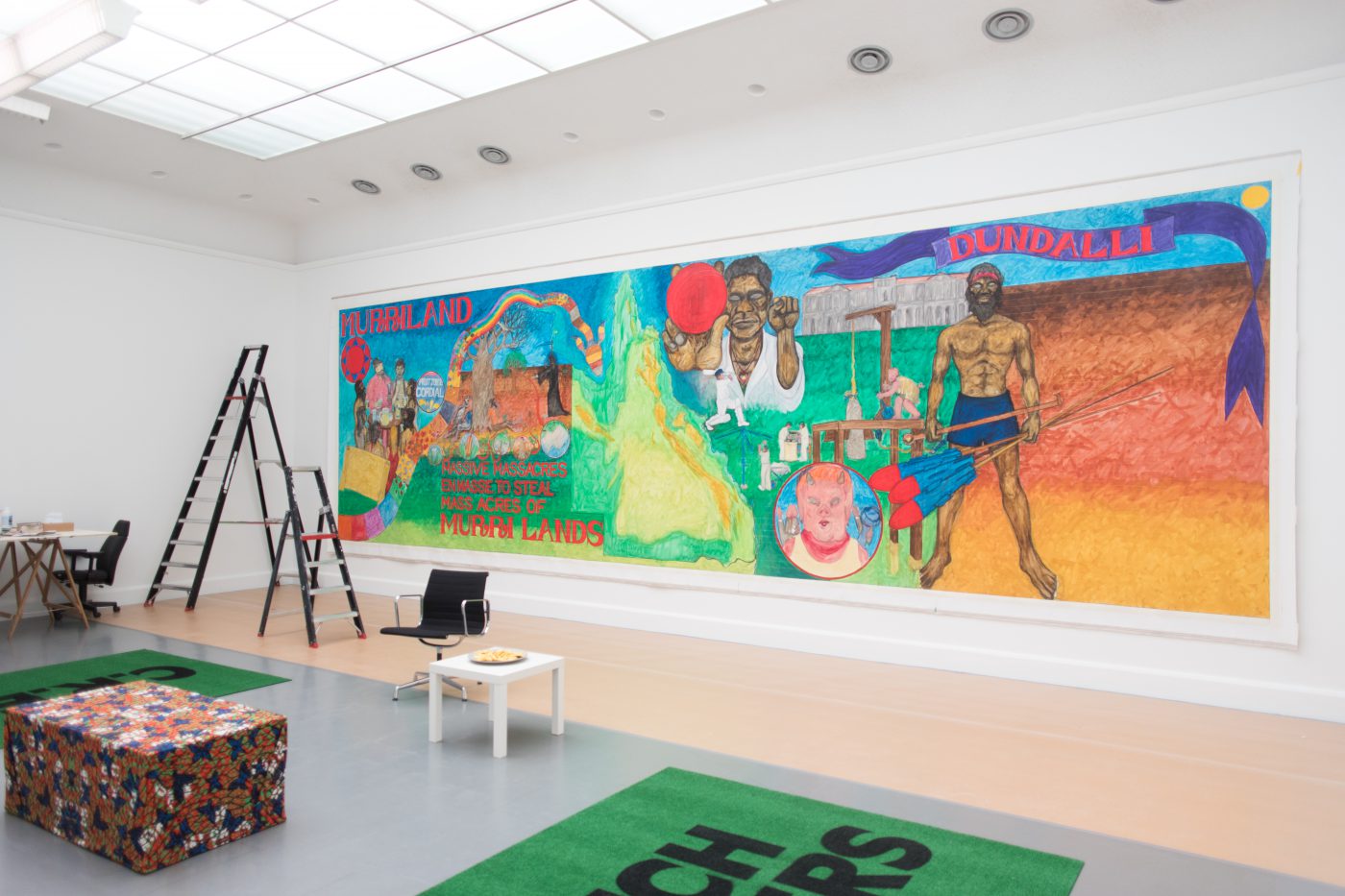
Mural Gordon Hookey, Van Abbemuseum, 2018
How to Aboriginalize Australian History – Talking to Gordon Hookey
Gordon Hookey appropiates historical events to comment on the colonial past and present of Australia. A new mural by Hookey is currently on show in the group-exhibition Trade Markings at the Van Abbemuseum, curated by Vivian Ziherl.
The painting you are working on at the Van Abbe Museum in the context of the exhibition Handelsmerken/Trade Markings is the second in a series called Murriland! (2015-ongoing). The first painting, also on show at Van Abbe, contains references to the time of Gondwanaland (a super continent that existed before the continental drift) all the way up to the 21st century. In other words, it has already covered the entire linear timeline of history. What’s next?
Well, I just keep painting. My attitude is that I pick random events on the timeline and do a picture of that. So there’s no sequence although I will try to connect images or events with each other. For example, I make a reference of the Dutch mapping 360 kilometres of one side of Queensland’s peninsula in the 1600s, and connect it with Captain Cook laying claim to the other side one hundred years later. Even though these events are a hundred years apart, they are connected. There are many different kinds of conceptual connections like this. Another example of this type of connection between seemingly disparate events, coming from the painting I am working on now, is the image of Dundalli (1820-1855). He was a powerful resistance fighter, and when Queensland was being colonized he kept the colonizers at bay for something like ten to fifteen years. They were basically scared of him. To symbolize that they were scared, I got him standing there, almost like a superhero, with spears in his hands. At the ends of the spears are nuclear war heads, because if humans are scared of anything, it would be nuclear war. At the same time however, this image of Dundalli holding the spears references Maralinga, the site where the British conducted nuclear tests on Aboriginal lands, often without removing the Aboriginal people.
"I take history and aboriginalize it, and I never let historical facts or a little bit of truth get in the way of a good painting"
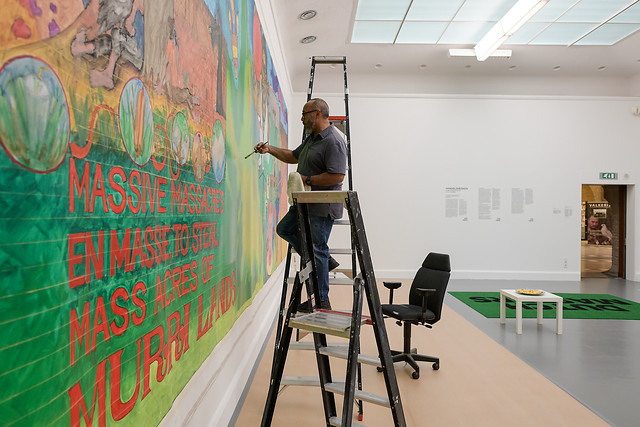
Gordon Hookey at work at the Van Abbemuseum, 2018
And the story of Dundalli is also connected to the present.
Yes. Dundalli was executed, but the attitude of those who executed him is the same of that of Pauline Hanson today. She is a rightwing politician and she is the face of racism in Australia. I’ve been at war with that sort of conservatism, ethnocentrism and racism throughout my career.
As with all your paintings, this one is filled with symbolism and narrative scenes that blend into each other. Can you talk us through some of the other components of the painting, perhaps starting with the scene on the left?
In the 1400s, long before European powers arrived in Australia, the Chinese were the most developed civilization. They had trade routes all across the Pacific and quite remarkable maps. Their way of thinking was way beyond the way of thinking of the day. The emperor of the time was very much aware of other people, other nations and other ways of living throughout the world. It is said that there was even a delegation of Aboriginal people that went to China for diplomatic and cultural reasons. The first part of the painting shows the cordial relations which existed between Aboriginal people and China. There’s the emperor himself, and then one of the most well-known Chinese people of all time: Bruce Lee. I’ve got them all sitting around having ‘cordial relations’, where Cordial also refers to an Australian concentrated fruit drink. I often use popular culture and iconic emblems in my work, as they carry a whole lot of meaning. I take history and aboriginalize it, and I never let historical facts or a little bit of truth get in the way of a good painting. Another person featuring in this painting is the cricketer Eddie Gilbert, an Aboriginal man who was born on a reserve and was ‘under the Act’ (Aboriginal Protection Act 1869, IdC). That means he wasn’t allowed off the reserve, but because he was such a good cricketer, he was given special exemption. In one game he played against Don Bradman. Bradman was like a national god of sport. Australia worshipped him because he was just so good at cricket. So Don comes out to bat, and Eddie Gilbert bowls at him and the first ball was so fast that Don Bradman fell over. After the second and third Don was ‘out for a duck’, which means he was out for zero. Don said in the dressing room that it was the fastest ball he ever faced. That was his initial reaction. Then after a while, he started telling everyone that Gilbert was bowling wrong, that he was breaking the rules. The media got on to it and Eddie Gilbert was basically trialed by media, crucified by the Australian public. After that game he was sent back to the mission, and they never let him play again. Some of the comments were so brutal and racist that Eddie Gilbert ended up dying in a lunatic asylum. So that was the story which I embellish by saying that the ball that was so fast made Don so scared he shit himself, and by saying that it was the day the phrase ‘shitting yourself’ came to mean being scared in the British language. By turning the history around from what it was to something else, I undermine the Anglo attitude, the racism and I take the shine off this so-called cricket hero.
The idea for this series came after being introduced to the work History of Zaire (1973-1974), a series of 101 paintings by the Congolese artist Tshibumba Kanda Matulu, also on show at the Van Abbe.
The thing is, I never worked with history before. My art was always about looking at issues and concerns that happen now as they unfold. When Vivian [Ziherl] commissioned me to paint the history of Queensland the way Tshibumba painted the history of Congo she must have seen something in both of our works. It was only later that I realized that the paintings I was doing of some more contemporary scenarios, like Mulrunji’s death in custody on Palm Island, will be history paintings in the future. Then again, they are not really history paintings, as much as paintings about history. I am not trying to capture history, I am trying to comment on history. I blatantly stretch the truth.
What do you think of the ambiguous status of Tshibumba’s work as belonging to an ethnographic collection and context, and also being shown in a contemporary art context?
Well, that’s the kind of attitude we are trying to change from within, as well as from without. My work is contextualized in this colonial trophy cabinet we call a museum. To show something in that context which contradicts it from within shows that a museum is not just a trophy cabinet for the rich, it can be a platform to make statements and giving someone the opportunity to call you an asshole.
The Van Abbemuseum is working hard to decolonize, or demodernize as they call it. I think they’re doing a great job and have a wonderful programme that addresses important issues. Nonetheless, I wonder if it is even possible for institutions of modern and contemporary art to really decolonize as they are and will always be at their foundation colonial institutions. I believe it was even Charles Esche himself who said that perhaps it’s better to take the institutions down altogether and start anew.
I think that would be good, to be honest: bulldoze everything down and start again. To me there is no such term as postcolonialism, or decolonization. There is no such thing because to me there is only one word: colonialism. You can put suffixes and prefixes on it but to me as a person who has been subjected to those forces, it still exists in its form. There’s just colonialism, there is no ‘de’ or ‘post’ or all these other theoretical constructs. They’re all still the same. I use the word neocolonialism to refer to the rise of the right, but it’s not really neo because it’s the same. It’s all just playing with words. To come up with a totally different word to mean what you mean, I think would be good, because it will disenfranchise the word you initially used. I use language in my work, but English is my second language. I don’t know my first language because colonialism has taken it away from me. Therefore I can use the English language any which way I want, with misspellings, making up my own words, and so basically bastardizing the colonizer’s language. With the addition of the meaning of words from history and theory it’s bringing into play elements of another discourse.
"Australia would rather live with a comfortable lie than the uncomfortable truth"
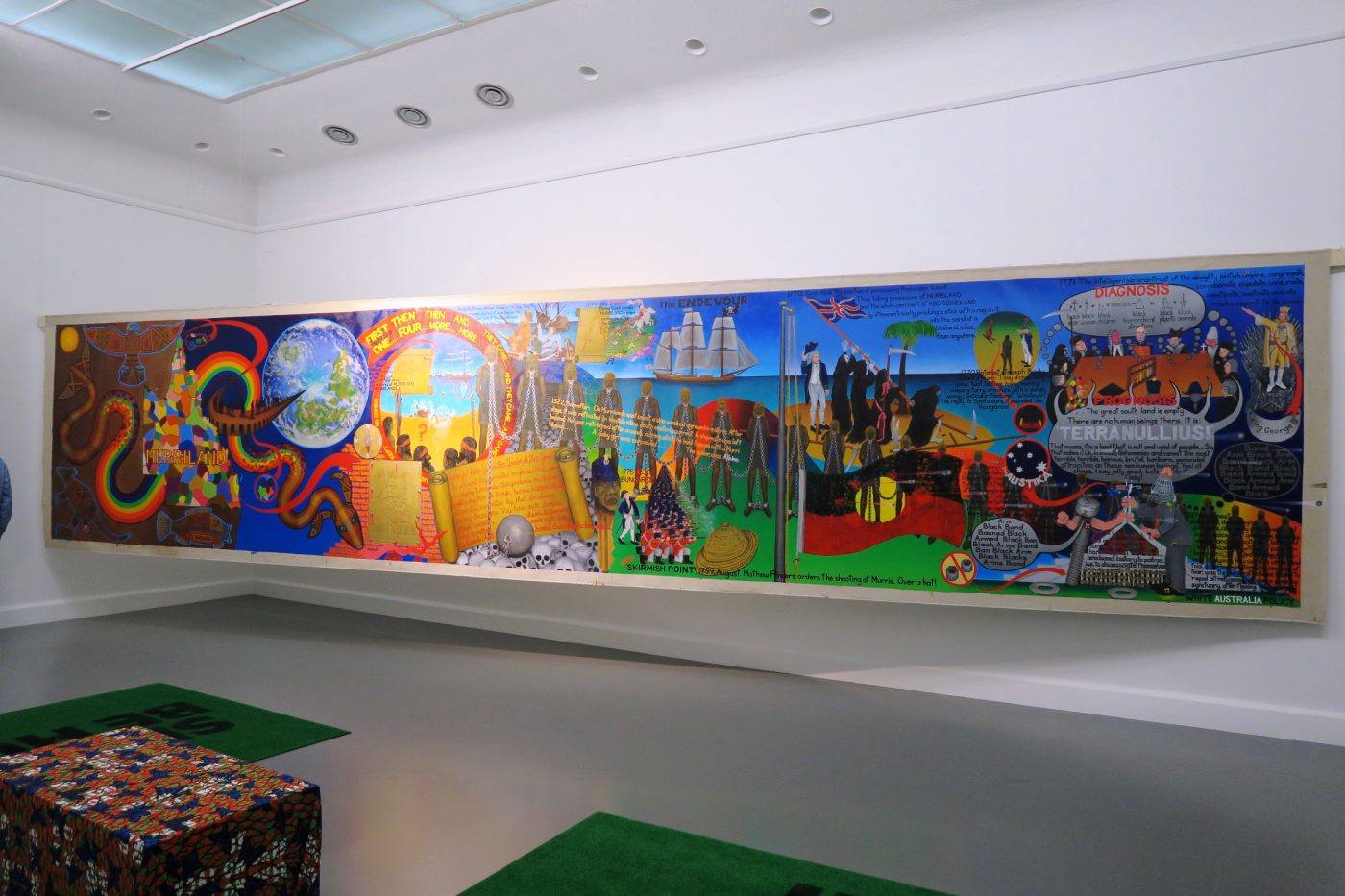
Gordon Hookey, work originally presented at documenta 14, Van Abbemuseum
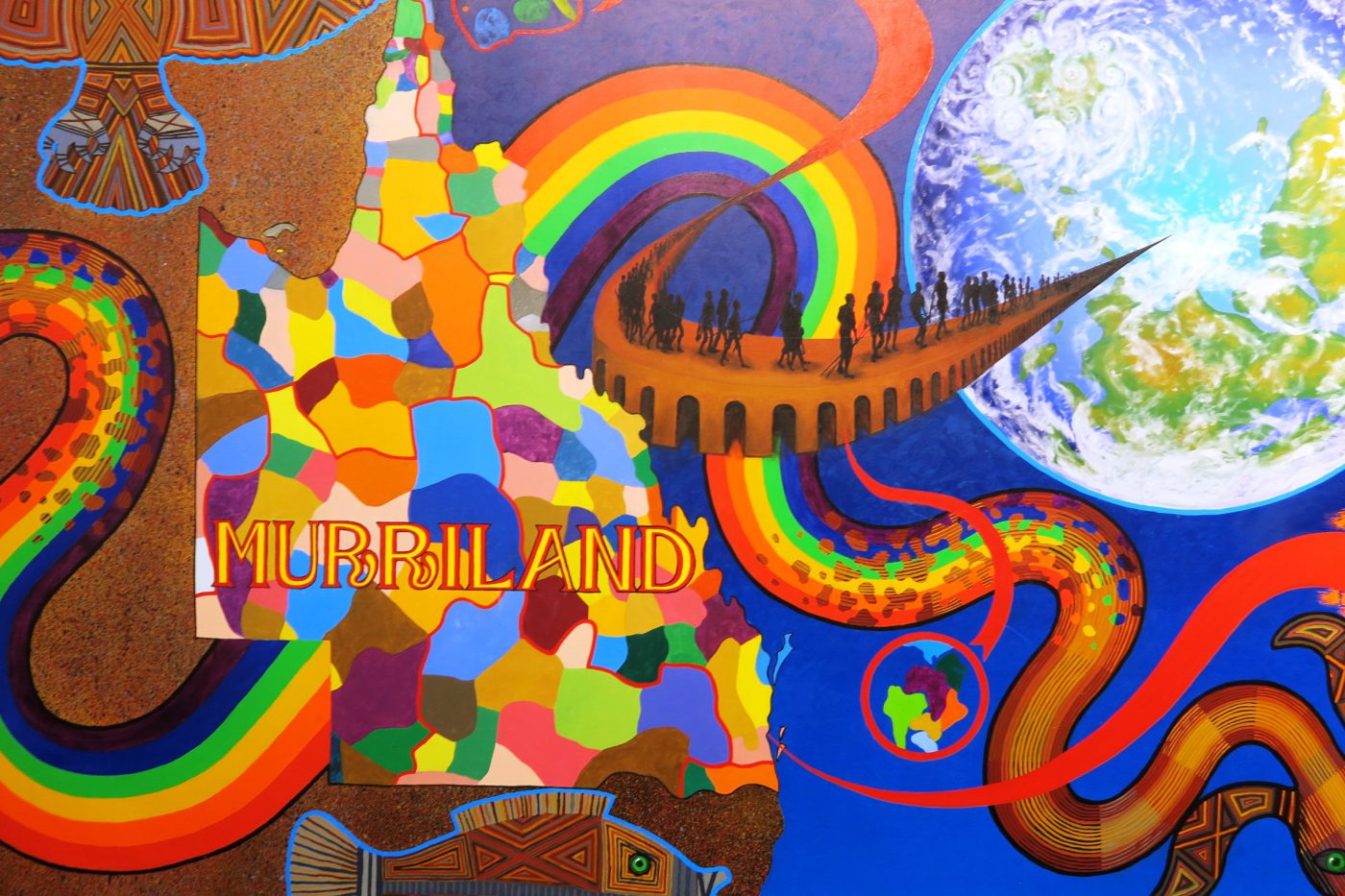
Detail painting
Murri is a broad term that covers all Aboriginal people of Queensland. Of course the geographical spread of Murri people does not neatly follow the lines drawn up on maps by the colonizers. The title of the series then seems to be in defiance against this specific history and aimed at reclaiming the land for its original inhabitants.
That is correct. Murriland refers to Queensland, which is England, but the land really belongs to Aboriginal people. In the first painting you see all the different Aboriginal nations within Queensland, but people in New South Wales or the Northern Territory could also refer to themselves as Murri. So the border isn’t specifically the border of Murriland, Murriland goes beyond the border. Murriland is a way of making a claim to our lands, but it also adds weight to us, as a collective group. It’s like sovereignty to a degree. We view ourselves as a sovereign people even though we are many different nations under the Aboriginal flag.
I get the feeling the paintings are also like maps in a way, perhaps mapping memory or other things that have been erased. Mapping is also a powerful tool of dominance as the history of colonialism shows.
The mapping of memory is quite a good metaphor. The majority of Australians dare not remember their history. Australia would rather live with a comfortable lie than the uncomfortable truth. There are these groups of historians that are the white blindfolded historians that whitewash Australia. According to them there were no colonial wars, there were no land grabs, there’s no stolen generation. As if the Aboriginals welcomed the English to steal their land. Australia is like a nation of Holocaust deniers who don’t want to know their own history. Australia is made up of people like that, and they’re in the government too. They take Aboriginal studies out of schools, they do not support bilingual education. Australia had the White Australia policy that only ended in the early 70s, but the White Australia policy still resides in the psyche of Australia today. So mapping memory to me is putting it out there: these are the things that Australia wants to forget, these are the things Australia says never happened. And by taking their version of things and altering that, in a way where metaphors come into play and where it can be read according to someone’s own context, is a valid way of doing it I think, because what it does is bringing up questions and creating discussions. The Murriland! paintings have not been shown in Australia yet, not the finished version at least. So it’ll be interesting to see the reaction to those works when they are finally shown there. Although generally in the arts, I am preaching to the converted. People who go and see art are generally in tune with what’s going on and what’s happening, but every now and then a conservative or a narrow-minded person will venture in and they can either be turned off or engage with it.
How is your work generally received in Australia?
In the past people have felt confronted by some of the overtly political work. I had a work called Sacred Nation, Scared Nation, Indoctrination, which is about the government making people scared so they can push through their policies. People were confronted by that and one journalist wrote quite provocatively about it, but that just drew attention to the work and more people came to see it, so he kind of shot himself in the foot. Because of the confrontational nature of some of my work people don’t engage with it or are afraid to write about it. Maybe because they don’t want to engage with the truth and the harsh political realities of our country. Politicians are very good at ignoring things too, because as soon as they comment on something it has to be engaged with and addressed, so they will ignore art altogether. And so I’ve been ignored a lot as well.
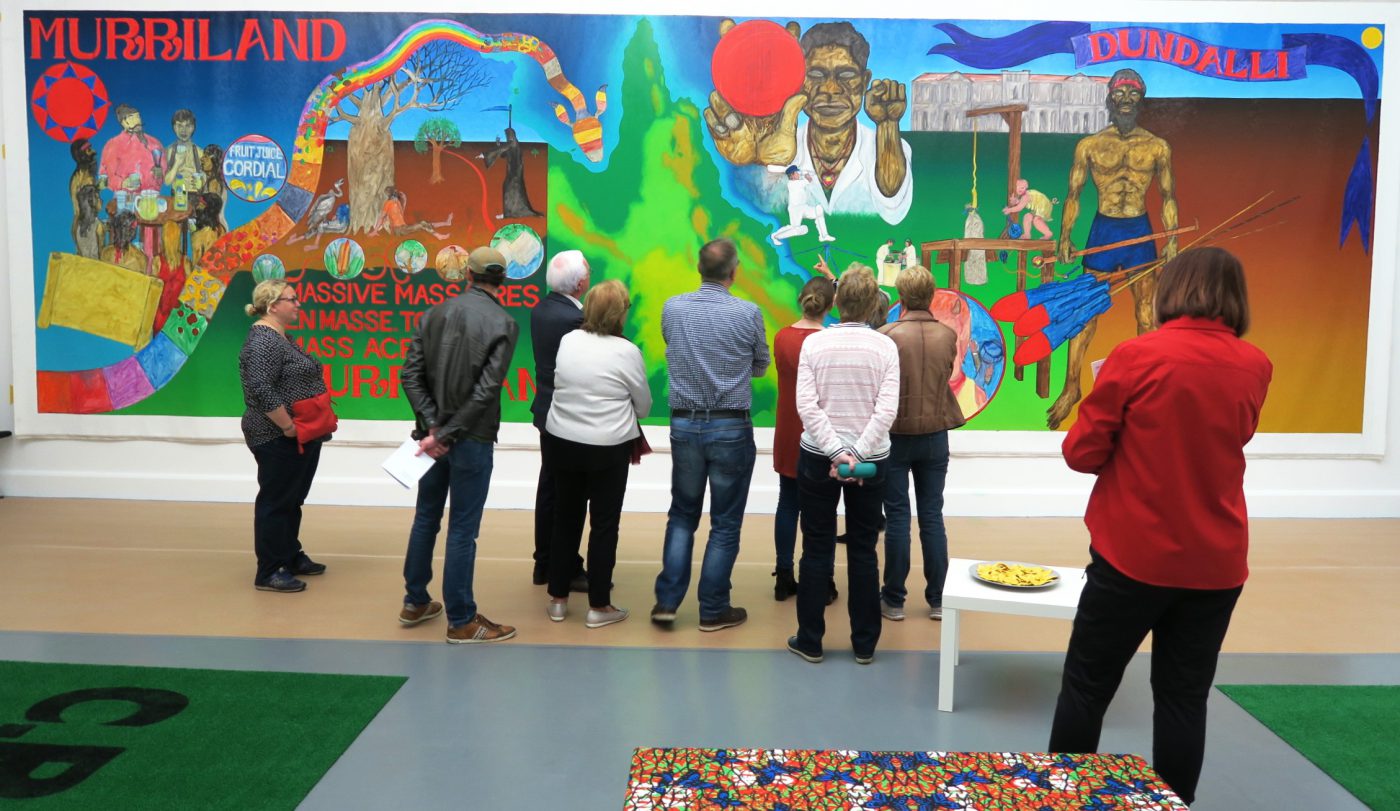
Installation view Gordon Hookey, Van Abbemuseum, 2018
But now that you’ve shown your work in documenta 14 for instance – at least from the Western perspective the most important art show there is – what does it mean for you and your work? Does it have any influence on the recognition of your work in Australia and for Aboriginal people in general?
For me documenta 14 was just another show. I don’t know whether I got more recognition, because there’s nothing tangible for me to say that I have. As far as I am concerned Australia is a lost cause, because Australian curators like the safe options. I am fortunate that Vivian [Ziherl] pulled me out of the Australian national discourse which I wasn’t fitting into anyway, and instead positioned me in the larger international discourse. Even though it is in a museum context, with all the problems we spoke about, at least it’s out there in the world.
Trade Markings: Frontier Imaginaries Ed. No. 5, Van Abbemuseum, until 01.07.2018
Irene de Craen


